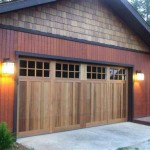How To Hang a Step Ladder in Your Garage: A Comprehensive Guide
Garages often become catch-all spaces for tools, equipment, and various household items. Maximizing space and maintaining organization are crucial for efficient use of this area. A step ladder, while essential for many tasks, can occupy significant floor space if not stored properly. Hanging a step ladder on a garage wall or ceiling is an effective solution for saving space and keeping the ladder readily accessible. This article provides a detailed guide on how to hang a step ladder in your garage, covering different methods, necessary materials, and safety precautions.
Choosing the Right Location and Orientation
Before beginning the installation process, carefully consider the optimal location for hanging the step ladder. The goal is to select a spot that is easily accessible, does not obstruct walkways or vehicle parking, and can structurally support the weight of the ladder. Assess the garage's layout to identify available wall space. Walls near the garage door opener or along the sides of parked vehicles are generally unsuitable due to potential obstructions. Aim for a location that is relatively free of existing clutter and allows for easy maneuverability around the hung ladder.
Determine the desired orientation of the ladder. Vertical hanging, with the ladder extending up and down, is often the most space-efficient method, particularly for taller ladders. Horizontal hanging, with the ladder extending side to side, may be preferable for shorter ladders or in garages with lower ceilings. Consider the structural support available in the chosen location. Walls with exposed studs are ideal, as they provide secure anchor points for mounting hardware. If the wall is drywall, it's imperative to locate the studs behind the drywall to ensure the mounting hardware is anchored to solid wood, not just the drywall itself.
Measure the dimensions of the step ladder, including its width, height, and depth when folded, to determine the amount of space required for storage. Account for any additional space needed for accessing and removing the ladder from its hanging position. Use a stud finder to locate the studs in the chosen wall area. Mark the stud locations clearly with a pencil. If studs are not readily accessible, consider using heavy-duty drywall anchors designed to support significant weight. However, anchoring to studs is always the preferred method for safety and stability.
Once the location and orientation are determined, consider the type of hanging hardware that will be most suitable. Various options are available, depending on the weight and size of the ladder, as well as the type of wall construction. Common choices include heavy-duty hooks, ladder hangers, and specialized storage racks. The next sections will elaborate on these different hardware options and their installation procedures.
Different Hanging Hardware Options and Installation
Several hardware options are available for hanging a step ladder in a garage. Each option offers different levels of support, ease of installation, and visual appeal. The selection should be based on the ladder's weight, the available space, and the desired level of accessibility.
Heavy-Duty Hooks: Heavy-duty hooks are a simple and cost-effective solution for hanging step ladders. These hooks are typically made of steel and are designed to support substantial weight. To install heavy-duty hooks, first mark the desired location on the wall, ensuring that the hooks will align with the folded ladder's rungs or frame. Pre-drill pilot holes into the studs using a drill bit slightly smaller than the screw size of the hooks. This step makes it easier to drive the screws and prevents the wood from splitting. Screw the hooks into the pre-drilled holes, ensuring they are securely fastened to the studs. Before hanging the ladder, test the hooks by applying downward pressure to confirm their stability. Using two or more hooks spaced appropriately will distribute the weight evenly and provide added security.
Ladder Hangers: Ladder hangers are specifically designed for storing ladders and feature a U-shaped design that cradles the ladder securely. These hangers are typically made of heavy-gauge steel and are coated with a protective finish to prevent rust and corrosion. Installation of ladder hangers is similar to that of heavy-duty hooks. Mark the desired location on the wall, ensuring that the hangers are aligned and spaced appropriately for the ladder's width. Pre-drill pilot holes into the studs. Attach the hangers to the wall using screws or lag bolts, depending on the hanger's design and the weight of the ladder. Ensure the hangers are firmly attached to the studs. Some ladder hangers also include a locking mechanism to prevent the ladder from accidentally falling. These are particularly useful in garages where vibrations might occur.
Specialized Storage Racks: Specialized storage racks offer a more sophisticated solution for storing step ladders and other tools. These racks often feature multiple compartments and hooks, allowing for organized storage of various items. Some storage racks are designed to be mounted on a wall, while others can be suspended from the ceiling. Wall-mounted storage racks are installed similarly to ladder hangers, requiring pre-drilling pilot holes and securing the rack to the studs with screws or lag bolts. Ceiling-mounted storage racks typically require more extensive installation, involving the use of chains or cables to suspend the rack from the ceiling joists. Ensure that the ceiling joists are capable of supporting the weight of the rack and the ladder. Use appropriate hardware, such as eye bolts and S-hooks, to securely attach the chains or cables to the joists and the rack. Level the rack to ensure it hangs evenly.
Safety Considerations and Best Practices
Safety should be the primary concern throughout the process of hanging a step ladder, from selecting the hardware to securing the ladder itself. Following these safety guidelines minimizes the risk of accidents and ensures the longevity of the installation.
Weight Capacity: Before purchasing any hanging hardware, verify its weight capacity. The hardware's weight capacity should exceed the weight of the step ladder by a significant margin. This provides a safety buffer and prevents the hardware from failing under the ladder's weight. Consult the manufacturer's specifications for the step ladder to determine its exact weight. Select hardware that is rated for at least 1.5 times the ladder's weight to ensure adequate support.
Proper Anchoring: As mentioned earlier, anchoring the hanging hardware to wall studs is the most secure method. Drywall alone is generally not strong enough to support the weight of a step ladder, especially over an extended period. Use a stud finder to accurately locate the studs behind the drywall. If studs are not accessible in the desired location, consider using heavy-duty drywall anchors designed to hold significant weight. These anchors typically feature a toggle bolt or expanding sleeve that provides a secure grip on the drywall. Follow the manufacturer's instructions for installing the drywall anchors, ensuring they are properly inserted and tightened.
Secure Fastening: Use appropriate screws or lag bolts to attach the hanging hardware to the wall studs or drywall anchors. The screws or lag bolts should be long enough to penetrate deeply into the studs or anchors, providing a secure hold. Avoid using short screws that may pull out under the ladder's weight. Tighten the screws or lag bolts securely, but avoid over-tightening, which can strip the threads or damage the wood. Regularly inspect the screws or lag bolts to ensure they remain tight and have not loosened over time. Re-tighten as needed to maintain the stability of the installation.
Clearance and Access: Ensure there is sufficient clearance around the hung step ladder to allow for easy access and removal. The ladder should not obstruct walkways, vehicle parking, or other frequently used areas of the garage. Consider the swing radius of the ladder when removing it from the hanging position. Provide ample space for maneuvering the ladder without bumping into other objects. If the ladder is hung high on the wall, consider using a step stool or small ladder to safely reach it. Avoid straining or overreaching, which can lead to falls or injuries.
Regular Inspection: Periodically inspect the hanging hardware and the step ladder for any signs of wear or damage. Check the hooks, hangers, or storage rack for rust, cracks, or bending. Inspect the screws or lag bolts to ensure they are tight and have not loosened. Examine the step ladder for any damage to the rungs, frame, or hinges. Replace any damaged hardware or components immediately to prevent accidents. Address any issues promptly to maintain the safety and integrity of the installation.
By following these guidelines, individuals can effectively hang a step ladder in their garage, maximizing space and ensuring easy access to this essential tool. Prioritizing safety and regularly inspecting the installation will provide long-term peace of mind and prevent potential accidents.
:max_bytes(150000):strip_icc()/121003510_1057830077990355_3746717106631243077_n1-bf709f786882483280a19767b56fce00.jpg?strip=all)
11 Ladder Storage Ideas You Ll Want To Copy

26 Best Ladder Storage Ideas

25 Completely Brilliant Garage Storage Ideas Abby Organizes

How To Hang A Ladder From The Ceiling 12 Steps With Pictures

Ladder Rack

Simple Ways To Hang A Ladder On Wall With Pictures Wikihow

Hanging A Ladder From The Ceiling How To Wilker Do S

Brilliant Ways To Organize The Garage Blue I Style

Heavy Duty Steel Organizer For Ladders Wheelbarrows Chairs Wall Mounted Storage Solution Garage Ladder Hanger

No Fail Ladder Storage Rack
Related Posts








